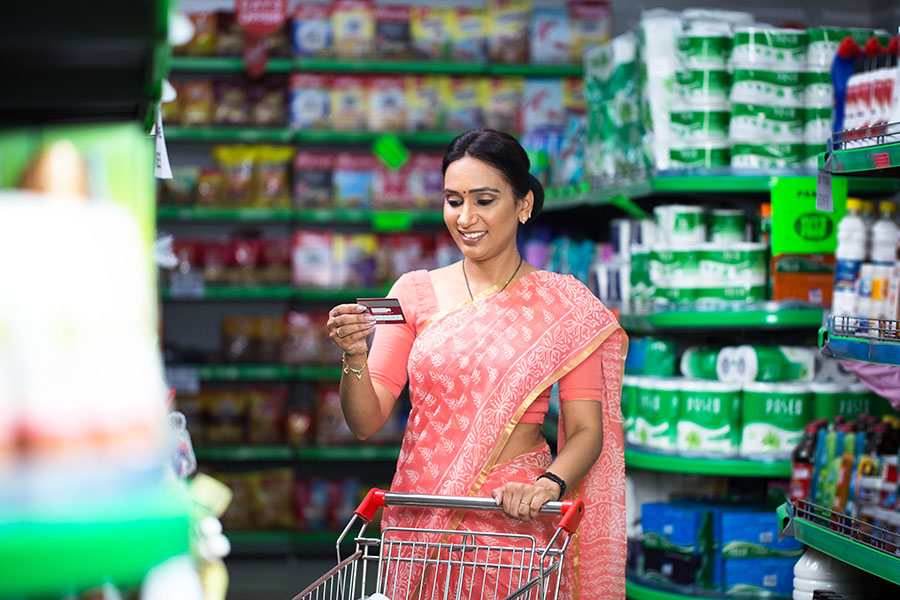
How credit card-linked UPI is a step toward better financial inclusion
India has emerged as the world leader in digital payments through UPI. Credit card-linked UPI is the next step to improve ease of access and hence the growth of the economy
 India is leading the way beyond most developed economies regarding digital payments. As per many reports, 48 billion transactions occurred in 2021 through UPI India is way ahead of economies like China which clocks around 18 billion transactions as of 2021 and has 6.5 times more than the US, UK, and Germany
Image: Shutterstock
India is leading the way beyond most developed economies regarding digital payments. As per many reports, 48 billion transactions occurred in 2021 through UPI India is way ahead of economies like China which clocks around 18 billion transactions as of 2021 and has 6.5 times more than the US, UK, and Germany
Image: Shutterstock
UPI and how it has enabled digital transactions in the country
The Reserve Bank of India (RBI), after the massive success of the Unified Payments Interface (UPI), has announced the linkage of credit cards and UPI. This move will position India as one of the pioneering countries in digital payments by giving the extra convenience of paying through credit. By doing so, India's economy will not only receive a boost but also extend the influence of its financial systems beyond the country.
India is leading the way beyond most developed economies regarding digital payments. As per many reports, 48 billion transactions occurred in 2021 through UPI India is way ahead of economies like China—which clocked around 18 billion transactions as of 2021 and has 6.5 times more than the US, UK, and Germany. Demonetisation, with its short-term discomforts, equipped our developing nation with an amplified use of digital payment gateways. While there were surcharges for keeping a swipe machine for cards, the UPI/digital payment options came in without such fixed costs for the consumers. The lack of tariffs for UPI led everyone, from small roadside vendors to the most prominent stores, to adopt digital payments. It also added another layer of convenience for the end-user. One could have a smartphone, which would also do the job of their wallet.
With a young demographic and rising smartphone adoption, the importance and scope of UPI are only going to increase. Moreover, after RBI's announcement on March 8, 2022, UPI transactions will become a standard feature in non-smartphones as well, with the UPI 123Pay positioned to let people with feature phones take advantage of this payment feature. With the option of using an IVR (voice-based system), missed calls, and a dedicated app for feature phones, UPI transactions will also bring millions of people without smartphones within the ambit of digital transactions. Once this move takes off, India will become a global powerhouse in financial transactions, driven primarily by UPI.
What is the reason behind enabling credit card integration with UPI?
RBI has added yet another form of convenience by integrating credit cards with UPI. One need not have liquid cash in the bank to enjoy the facility of UPI. This has its own set of pros and cons. One of the most significant advantages of this facility is that when one's money is parked in ETFs, mutual funds, and real estate, one needs to keep little liquid money resting in the low or no-return bank accounts and pay for as much one spends later. Through this facility, people no longer need to worry about paying for goods, especially small-ticket transactions like restaurants and grocery shops, if one does not have liquid money at that instant. For the youth in urban India, which is known to be savvy regarding investments and savings, this facility will promote even further the culture of saving and investing while being conservative in their spending habits—after all, the use of UPI adds convenience. Still, it doesn't change the fundamental principle of paying back money used on credit.Also read: How co-lending is changing the credit landscape in India
Apart from youngsters in urban India, this move will also make it easy for the low-income segment in Tier II and III cities to go back to short-term credits, which could make goods more accessible. Why do we say 'going back'? That is because in the older times, or probably even now, many small vendors rely on keeping a "Khaata" or a credit-based account for their regular customers and taking payments weekly or monthly. That is especially prevalent when the trust factor is high and customers' purchase timings do not coincide with their income. The credit card linked to the UPI will act like that along with the added advantages. Moving to digital credits will substantially reduce the probability of the shopkeeper cheating customers by overwriting monthly accounts. Moreover, given that a significant percentage of the rural and small-town economy runs on the concept of credit, the increased transparency will allow this financial system to run smoothly.
One potential use for the unbanked sections of the Indian society, which may bring a revolution in getting more people into the ambit of banking, is the use of credit card-linked to start someone's credit history and establish credit worthiness. Since UPI addresses (and thereby bank accounts) can be linked with Aadhar cards, for people with no credit history, banks can provide them with short-term credit cards with modest credit limits (say 10,000). The very first benefit of this would be to introduce the unbanked people with credit that can be spent, repaid, and monitored, thus educating them about concepts like credit cards, digital banking, and mobile banking.
With this newfound awareness, they can take a proactive role in managing their finances. In case of default, their newly established creditworthiness will take a hit, and they will be rendered ineligible for other loans such as home loans, loans for small businesses, car loans, and so on. While some percentage of default may happen, banks can minimise it by using auto-debit block and by an extensive awareness campaign highlighting the importance of using credit wisely and repaying it on time.
Moreover, the linkage with the Aadhar card will also bring the person's other bank accounts into the picture. If the credit money is not paid beyond a certain default period, the banks shall also block the person's other linked accounts and debit methods until they release the payment. Mobile companies are already using a similar feature like this through lease-based sales of mobile phones. If one doesn't pay the lease amount, the company locks all mobile phone features, thereby compelling the customer to make the payment.
Given so many potential benefits to the Indian society in terms of ease of transaction, increase in enrollment in the banking system, and more remarkable growth of financial systems that promote transparency, it may seem that there are no pitfalls. However, some concerns and potential disadvantages must be kept in mind. Indians, on average, spend 67 percent of their income, whereas, in the United States, this proportion is a little over 100 percent. That has led to many defaults in short-term debt paybacks in the USA. The ease and access to short-term credit encourage short-term thinking geared towards gratification. With its much smaller per capita economy, an economy like India cannot afford to be on the American path.
Also read: Coinbase suspends UPI payments in India three days after launch
Furthermore, although that path may create a lucrative retail-friendly economy, it comes with the potential threat of default cycles that may trigger recession cycles, hitting the economy badly. While high per capita economies with tremendous amounts of tax collection have the cushion to feed their people in such challenging times, one can't really see how a low per capita economy like India would cope with the same. Another concern is that in a country where banks are known to employ strong-arm tactics to recover money from some people while being lenient towards more prominent businesses, the unwise use of this facility may encourage even more financial inequality.
Operational issues and the way forward
India's movement towards UPI and cashless payments play a pivotal role in changing the Indian economy. Issues such as Merchant Discount Rate (MDR) and their variation based on providers like Visa, RuPay, and MasterCard still need to be ironed out. Moreover, the use of this facility in B2B business and how it will differ from B2C still need to be ironed out.Another issue that must be solved is mitigating black money and under-the-table transactions. One of the solutions is that by including even credit-based transactions under the ambit of UPI, the likelihood of more transparent transactions will be significantly increased. Also, this will be a significant step in bringing digital transactions to the informal sectors of the economy. For urban India, it enables yet another transaction mode that combines credit and UPI.
Also read: Future of Money—Digitalisation will help in value creation: Gaurav Deepak
Despite the potential pitfalls and the need to clarify several implementation aspects, the author is confident that, given the traditionally conservative nature of Indian people when it comes to financing, this move will boost people's ease of payment while transforming the Indian economy. Systematic implementation in gradual steps and close monitoring of its effect on the economy will go a long way in enabling the benefits to be reaped while obviating some potential disadvantages.
The authors foresee the following happening: A massive increase in financial literacy across the nation, improved connectivity between the remote parts of the country and the
cities due to increased financial connections, increased prosperity among the rural population as they take charge of their finances, increased influence and growth of public sector banks (and hopefully better management), and greater transparency in Indian finance and economy.
Abhinav Gupta is a PGP student and the president of the Public Policy Club the at the Indian School of Business (ISB). Avik Sarkar is a Faculty at ISB, and his work focuses on the interface of Public Policy and technology.
[This article has been reproduced with permission from the Indian School of Business, India]

















